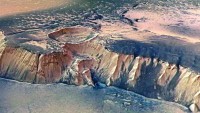Arctic Ocean Acidification: What Are The Causes of This Phenomenon?
| Ina Ariola | | Jun 17, 2015 12:00 AM EDT |
(Photo : Getty Images/ Joe Raedle) Several factors contribute to Arctic Ocean acidification, and these are human-caused carbon dioxide emissions, melting glaciers, upwelling of carbon-dioxide rich deep waters, freshwater from the rivers and cold water.
Arctic Ocean is facing a dilemma today and that is acidification. Ocean acidification is a result or a chemical reaction which happens when seawater absorbs too much carbon dioxide from the atmosphere—reducing its acidity, carbon ion concentration and saturation.
Seawaters need to be saturated with calcium carbonate minerals, such as argonite, which are needed by many marine species because they act as building blocks for their skeletons and shells.
Like Us on Facebook
Continuous ocean acidification causes the water to be less saturated with these minerals. It will affect not just the capacity of some sea creatures to produce and maintain their shells but also the entire marine ecosystem, Eurek Alert! reported.
To address this growing challenge, it is very important that we make ourselves aware what causes this occurrence. According to Science Daily, absorption of carbon dioxide emitted by humans and man-made machines isn't the only one contributing to the acidification process.
Here are the other contributing factors to Arctic Ocean acidifcation:
1. The melting of the glaciers.
Very low carbonate materials can be found on glacial-meltwaters. Once the water from melted glaciers mixes with seawater, it's going to dilute the calcium carbonate concentration.
2. The upwelling of deep waters.
Deep water has lower acidity compared to surface waters because it carries more carbon dioxide. It will decrease the acidity and saturation of the surface water when it rises, hence the ocean acidification.
3. The running freshwater from the rivers.
River water running off from North America and Eurasia to the Arctic Ocean can cause acidification because it has large amounts of carbon dioxide from organic matter.
Organic matter remineralization by organisms produces carbon dioxide. As it increases, calcium carbonate in the water becomes less saturated.
4. Cold waters can absorb more carbon dioxide compared to warm waters.
Cold water can dissolve and carry more carbon dioxide than warm water. The addition of cold water from melted ice contributes to ocean acidification. It also disrupts ocean circulation, which plays an important role in climate regulation and weather patterns.
Global warming and Anthropogenic Climate Disruption are scientific realities. They are issues that need to be addressed urgently.
In line with this, there have been reports revealing that the United Nations and the Vatican joined forces in warning the world about the effects of Anthropogenic Climate Disruption.
The reason is that despite the facts presented by scientists, there are still many skeptics who chose to ignore the reality, Global Research learned.
Kofi Annan, the Former UN Secretary General, challenged people who kept on denying the reality, while Pope Francis directed the Catholic Church leaders to join politicians, economists and scientists in looking for a favorable solution.
TagsArctic Ocean, ocean acidification, global warming, Science
©2015 Chinatopix All rights reserved. Do not reproduce without permission
EDITOR'S PICKS
-

Did the Trump administration just announce plans for a trade war with ‘hostile’ China and Russia?
-

US Senate passes Taiwan travel bill slammed by China
-

As Yan Sihong’s family grieves, here are other Chinese students who went missing abroad. Some have never been found
-

Beijing blasts Western critics who ‘smear China’ with the term sharp power
-

China Envoy Seeks to Defuse Tensions With U.S. as a Trade War Brews
-

Singapore's Deputy PM Provides Bitcoin Vote of Confidence Amid China's Blanket Bans
-

China warns investors over risks in overseas virtual currency trading
-

Chinese government most trustworthy: survey
-

Kashima Antlers On Course For Back-To-Back Titles
MOST POPULAR
LATEST NEWS
Zhou Yongkang: China's Former Security Chief Sentenced to Life in Prison

China's former Chief of the Ministry of Public Security, Zhou Yongkang, has been given a life sentence after he was found guilty of abusing his office, bribery and deliberately ... Full Article
TRENDING STORY

China Pork Prices Expected to Stabilize As The Supplies Recover

Elephone P9000 Smartphone is now on Sale on Amazon India

There's a Big Chance Cliffhangers Won't Still Be Resolved When Grey's Anatomy Season 13 Returns

Supreme Court Ruled on Samsung vs Apple Dispute for Patent Infringement

Microsoft Surface Pro 5 Rumors and Release Date: What is the Latest?












